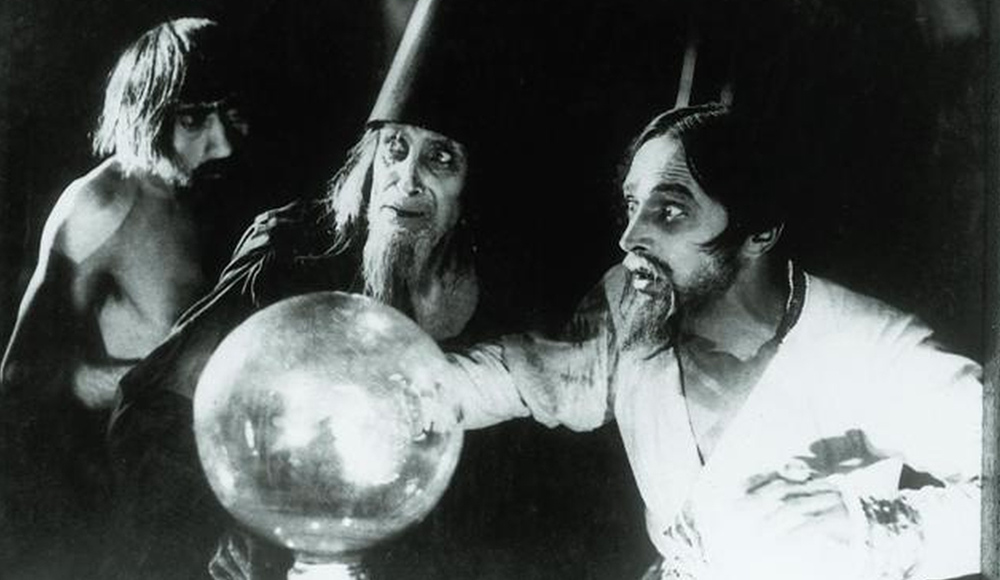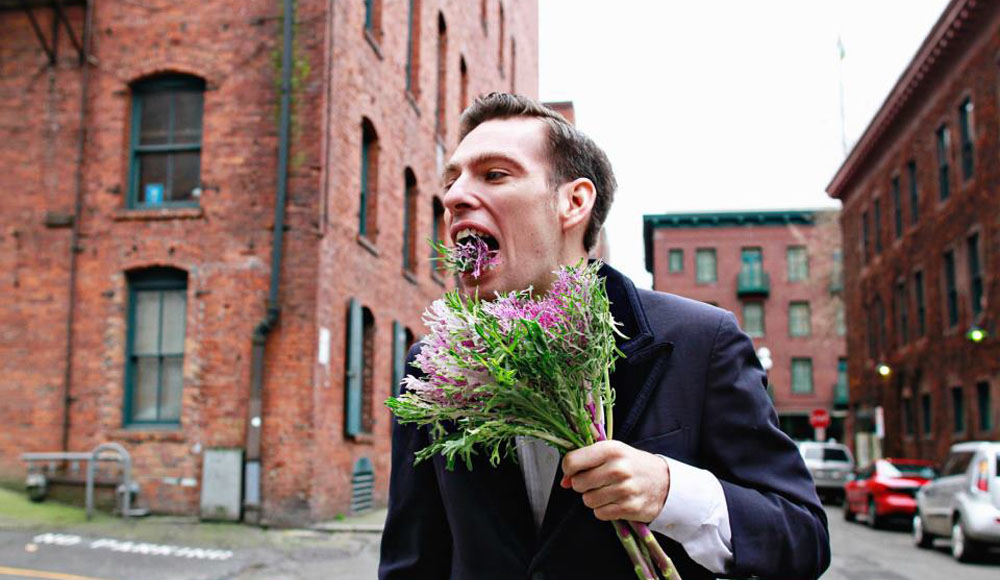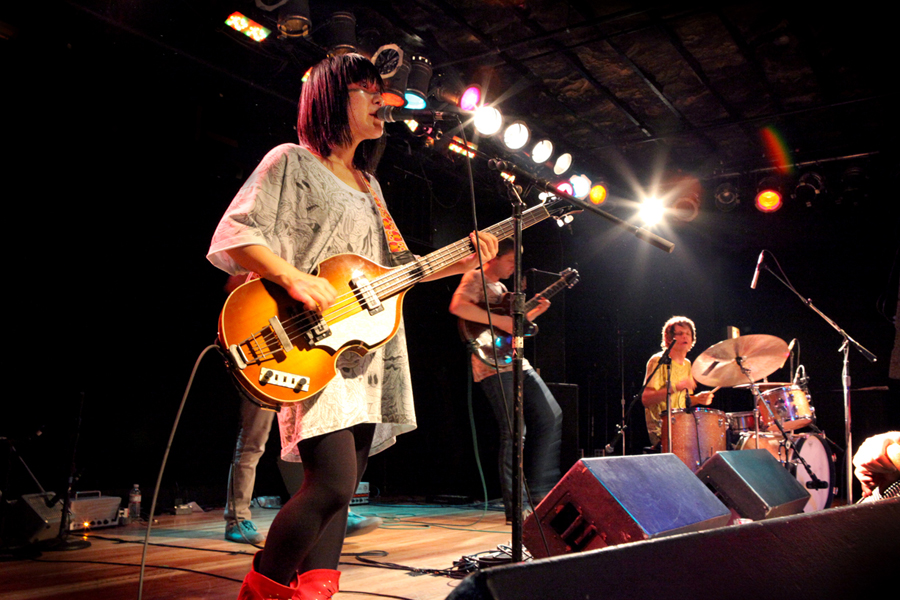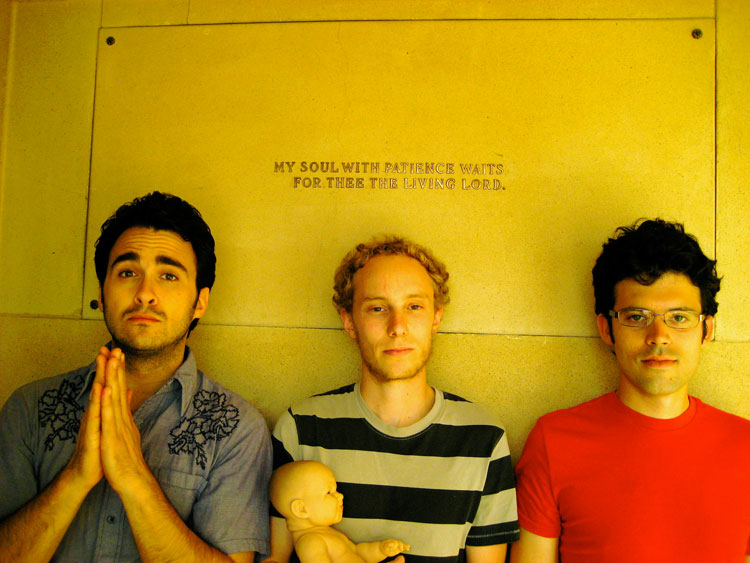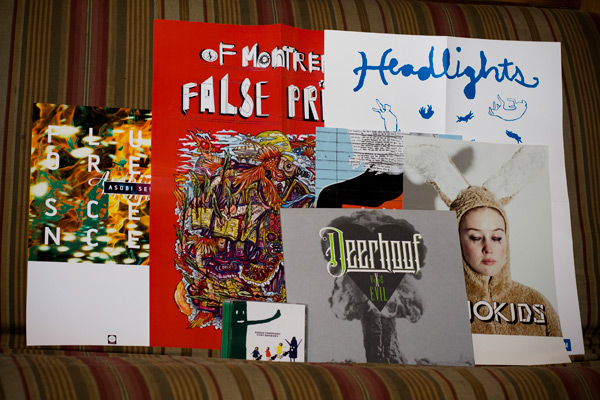The San Francisco International Film Festival has made a tradition of assembling a live musical group each year to score a silent film. In the past, this has included artists like Stephen Merritt, Yo La Tengo, Deerhoof, and Black Francis. In 2013, the festival has put together an ensemble including Mike Patton (Faith No More), Scott Amendola (Nels Cline Singers), Matthias Bossi (Sleepytime Gorilla Museum), and William Winant (Mr. Bungle) to score the 1924 fantasy-horror classic Waxworks, directed by Paul Leni.
Deerhoof
Video: Jherek Bischoff’s “Young and Lovely” f. Zac Pennington & Soko
Get ready to hear the name Jherek Bischoff a lot more often. The multi-instrumentalist, composer, producer, and ex-Parenthetical Girls member has crafted an epic orch-pop debut called Composed, which is coming via Brassland on June 5.
And if you need a few familiar names to get you interested, the album features David Byrne, Nels Cline (Wilco, Nels Cline Singers), Craig Wedren (Shudder to Think), Greg Saunier (Deerhoof), Zac Pennington (Parenthetical Girls), Soko, Carla Bozulich, Dawn McCarthy (Faun Fables), and even more notables.
The Groove Seeker: Tune-Yards’ Whokill
The Groove Seeker goes in search of killer grooves across rock, funk, hip hop, soul, electronic music, jazz, fusion, and more.
 Tune-Yards: Whokill (4AD, 4/19/11)
Tune-Yards: Whokill (4AD, 4/19/11)
Tune-Yards: “Bizness”
[audio:https://alarm-magazine.com/wp-content/uploads/2011/04/06-Bizness.mp3|titles=tUnE-yArDs: “Bizness”]If you’ve ever seen Merill Garbus’ Tune-Yards play live, you understand how resourceful and creative a musician she is. With a ragtag set of drums and ukulele close at hand, Garbus builds her songs from scratch by live-looping repetitive drum and vocal patterns. Crafty to say the least, her performances are a multitasking puzzle of pedal stepping and vocal-scat arranging, revealing compositions and melodies that are spontaneous but clearly logical.
As Tune-Yards, Garbus surprised many with a gem of a debut in 2009. That record, Bird-Brains, thrives on the same weirdness and DIY attitude that make Garbus’ live shows so enjoyable. Not only were the songs recorded using a freeware program, but the folk-inspired experiments are packed with field recordings, Dictaphone samples, and intermittent elements of R&B and hip hop, all loosely fastened down by Garbus’ versatile Afro-pop-influenced vocals.
Whokill, Garbus’ second album under the case-sensitive moniker (generally stylized as tUnE-yArDs), sees her trading in the Dictaphone for some full-blown studio time. Tracked and mixed by Eli Crews (producer for Deerhoof and Why?), with co-writing credits going to bassist Nate Brenner (Beep), the record shows definite growth from those lo-fi-recording days. Thankfully, a bit of studio polish doesn’t take away her charm and musical wit. If anything, the new approach gives her avant-garde pop the right venue in which to be properly heard.
Concert Photos: Deerhoof @ Bottom Lounge (Chicago, IL)
Experimental-rock band Deerhoof, the recent focus of an ALARM Q&A, is currently touring material from its most recent release, Deerhoof Vs. Evil. In a stop at Bottom Lounge in Chicago, vocalist Satomi Matsuzaki, bedecked in face paint and big red boots, jumped about the stage as the band tore through its avant-rock collection of controlled chaos. As photographer Elizabeth Gilmore‘s photos below show, it was just another off-the-wall, endlessly inventive performance.
Q&A: Deerhoof
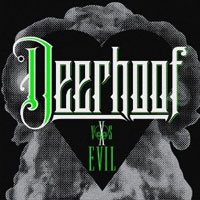 Deerhoof: Deerhoof vs. Evil (Polyvinyl, 1/25/11)
Deerhoof: Deerhoof vs. Evil (Polyvinyl, 1/25/11)
Deerhoof: “The Merry Barracks”
[audio:https://alarm-magazine.com/wp-content/uploads/2011/01/03-The-Merry-Barracks.mp3|titles=Deerhoof: “The Merry Barracks”]If you’re familiar with the band, it takes less than 10 seconds to recognize a Deerhoof song. If bassist/vocalist Satomi Matsuzaki‘s beautiful, extraterrestrial voice and seemingly improvised lyrics don’t tip you off, surely the impetuous drumming of Greg Saunier, or the sharply jangled guitars of John Dieterich and Greg Rodriguez, will. Like a Galapagos of music, the quartet has evolved purely on its own, each member an island and each song a new creation found nowhere else on Earth.
The band’s dynamic approach to songwriting has led to a catalog stuffed to the brim with experimentation, and its tenth studio album, Deerhoof vs. Evil, is no exception. Here, Dieterich answers some questions from the road and kindly reveals his secret weapon in the ongoing battle against evil.
What happened in the past two years to influence the sound of the new record?
I guess the main thing that happened was that we all moved away from the San Francisco area and ended up in different cities. So we have had to figure out a new way of operating as a band and try to stay connected, even from far away.
What is the current dynamic in the band in terms of songwriting? How are the songs constructed?
Each song is different, but the basic method is the same, in that everyone writes on their own and brings in their ideas, whether it’s in the form of recorded ideas and demos, or a guitar or bass riff or a vocal line, or whatever. Then, as a band, we just try to get it to a place where everyone is happy with it and feels like it’s something we want to do. A lot of material gets thrown away, as well.
The Groove Seeker: The Go! Team’s Rolling Blackouts
On a weekly basis, The Groove Seeker goes in search of killer grooves across rock, funk, hip hop, soul, electronic music, jazz, fusion, and more.
 The Go! Team: Rolling Blackouts (Memphis Industries, 2/1/11)
The Go! Team: Rolling Blackouts (Memphis Industries, 2/1/11)
The Go! Team: “The Running Range”
[audio:https://alarm-magazine.com/wp-content/uploads/2011/01/10-The-Running-Range.mp3|titles=The Go! Team: The Running Range]Originally Ian Parton’s solo home-brewed music project, The Go! Team became a six-member band upon the release of its debut, Thunder, Lightning, Strike, in 2004. As Parton put together a group to perform the music live, the pieces fell into place, and the band quickly became the highlight of international music festivals.
After running into copyright issues surrounding TLS’ samples, The Go! Team released Proof of Youth in 2007 — a sophomore-slump-dodging record that proved that Parton’s distinct patchwork funk pop was not a fluke. Four years later, the Brighton, England-based sextet is back with Rolling Blackouts, a rambunctious effort that leans toward ’60s-inspired pop. Building off its trusted template with a slew of guest vocals, including Best Coast’s Bethany Cosentino and Deerhoof’s Satomi Matsuzaki, the team’s upbeat blend of garage rock, hip hop, and noise pop sounds as refreshing at it did when Parton began.
Record Review: Deerhoof’s Deerhoof vs. Evil
 Deerhoof: Deerhoof vs. Evil (Polyvinyl, 1/25/11)
Deerhoof: Deerhoof vs. Evil (Polyvinyl, 1/25/11)
Deerhoof: “Merry Barracks”
[audio:https://alarm-magazine.com/wp-content/uploads/2011/01/03-The-Merry-Barracks.mp3|titles=Deerhoof: “The Merry Barracks”]It’s so easy to get caught up in Deerhoof’s little eccentricities that it’s worth reminding people that the quartet is also a solid rock outfit — albeit with a supremely jagged sense of rhythm. Deerhoof tends to play these sides against each other expertly: Satomi Matsuzaki’s vocals are usually the first thing to throw people off, but they also often center the songs with hooky energy. Greg Saunier’s scurrying, splattered drums give the songs a feeling of constant ambush, but also let you know that all this madness is definitely going somewhere.
Deerhoof’s work often shows how much craft, instinct, and care goes into sounding bonkers. Deerhoof Vs. Evil bets that those qualities can remain when the racket is turned down. That’s not to say the record lacks the band’s usual joyous frivolity, or even that there’s less of it going on at once; it just offers chances to slow down and appreciate how pretty Deerhoof’s music can be.
That’s a refreshing direction to hear after the band’s last full-length in 2008, Offend Maggie. For as strong as that album is, the blocky, straining chords of “The Tears And Music Of Love” and “My Purple Past” sound like a band trying to wear itself out on blunt-force rocking for good. Evil looks for resources outside the drum-driven rock format and exerts unabashed, spit-shined control over what it finds.
The Groove Seeker: Beep’s City of the Future
On a weekly basis, The Groove Seeker goes in search of killer grooves across rock, funk, hip hop, soul, electronic music, jazz, fusion, and more.
 Beep: City of the Future (Third Culture Records, 1/18/11)
Beep: City of the Future (Third Culture Records, 1/18/11)
Beep: “Robo Pup”
[audio:https://alarm-magazine.com/wp-content/uploads/2011/01/BEEP_Robo_Pup.mp3|titles=Beep: “Robo Pup”]
San Francisco-based trio Beep has tapped into a fresh vanguard with its upcoming release City of the Future. The indie-rock-meets-experimental-jazz trio is commanding without being loud, making the dynamics and improvisational strategies of jazz accessible to a whole new audience. City of the Future contains pieces that advance rather than deconstruct in an accomplished style that forgoes any art-school tropes narrowly associated with the experimental tag.
Produced by Eli Crews (producer for Deerhoof and Why?), the record is marked by passionate percussion and a broad sense of what a melody can sound like. Making avant garde sound closer than ever to the present, Beep has found a sound that mixes the vibrancy of the modern rock recording with the experimental subtleties of a jazz record.

